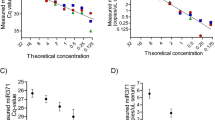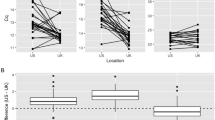Abstract
Background
MiR-371a-3p predicts the presence of a macroscopic non-teratomatous germ cell tumour (GCT). We hypothesised that miR-371a-3p can also detect recurrence during active surveillance (AS) of stage I GCT.
Methods
We prospectively collected serum samples of 33 men. Relative expression of serum miR-371a-3p levels was determined at each follow-up visit using real-time quantitative reverse transcription-polymerase chain reaction.
Results
Recurrence was detected using standard follow-up investigations in 10/33 patients (30%) after a median of 7 months. Directly after orchiectomy, miR-371a-3p levels were not elevated in any of the 15 patients with available post-orchiectomy samples. However, all ten recurring patients exhibited increasing miR-371a-3p levels during follow-up, while miR-371a-3p levels remained non-elevated in all but one patient without recurrence. MiR-371a-3p detected recurrences at a median of 2 months (range 0–5) earlier than standard follow-up investigations.
Conclusions
MiR-371a-3p levels immediately post orchiectomy are not predictive for recurrences and unfortunately cannot support decision-making for AS vs. adjuvant treatment. However, miR-371a-3p detects recurrences reliably and earlier than standard follow-up investigations. If this can be confirmed in larger cohorts, monitoring miR-371a-3p could replace surveillance imaging in seminomatous GCT and reduce the amount of imaging in non-seminomatous GCT. Earlier detection of disease recurrence may also reduce the overall treatment burden.
This is a preview of subscription content, access via your institution
Access options
Subscribe to this journal
Receive 24 print issues and online access
$259.00 per year
only $10.79 per issue
Buy this article
- Purchase on Springer Link
- Instant access to full article PDF
Prices may be subject to local taxes which are calculated during checkout

Similar content being viewed by others
Data availability
Data are available upon request.
References
Kollmannsberger C, Tandstad T, Bedard PL, Cohn-Cedermark G, Chung PW, Jewett MA, et al. Patterns of relapse in patients with clinical stage I testicular cancer managed with active surveillance. J Clin Oncol. 2014. https://doi.org/10.1200/jco.2014.56.2116.
Tarin TV, Sonn G, Shinghal R. Estimating the risk of cancer associated with imaging related radiation during surveillance for stage I testicular cancer using computerized tomography. J Urol. 2009;181:627–32. discussion 632–623.
Huang MM, Su ZT, Cheaib JG, Biles MJ, Allaf ME, Patel HD, et al. Cost-effectiveness analysis of non-risk-adapted active surveillance for postorchiectomy management of clinical stage I seminoma. Eur Urol Focus. 2020. https://doi.org/10.1016/j.euf.2020.06.012.
Almstrup K, Lobo J, Mørup N, Belge G, Rajpert-De Meyts E, Looijenga LH, et al. Application of miRNAs in the diagnosis and monitoring of testicular germ cell tumours. Nat Rev Urol. 2020;17:201–13.
Rothermundt C, Thurneysen C, Cathomas R, Müller B, Mingrone W, Hirschi-Blickenstorfer A, et al. Baseline characteristics and patterns of care in testicular cancer patients: first data from the Swiss Austrian German Testicular Cancer Cohort Study (SAG TCCS). Swiss Med Wkly. 2018;148:w14640.
Murray MJ, Bell E, Raby KL, Rijlaarsdam MA, Gillis AJ, Looijenga LH, et al. A pipeline to quantify serum and cerebrospinal fluid microRNAs for diagnosis and detection of relapse in paediatric malignant germ-cell tumours. Br J Cancer. 2016;114:151–62.
Bell E, Watson HL, Bailey S, Murray MJ, Coleman N. A robust protocol to quantify circulating cancer biomarker microRNAs. Methods Mol Biol. 2017;1580:265–79.
Blondal T, Nielsen SJ, Baker A, Andreasen D, Mouritzen P, Teilum MW, et al. Assessing sample and miRNA profile quality in serum and plasma or other biofluids. Methods. 2013;59:S1–S6.
Murray MJ, Halsall DJ, Hook CE, Williams DM, Nicholson JC, Coleman N. Identification of microRNAs From the miR-371~373 and miR-302 clusters as potential serum biomarkers of malignant germ cell tumors. Am J Clin Pathol. 2011;135:119–25.
Livak KJ, Schmittgen TD. Analysis of relative gene expression data using real-time quantitative PCR and the 2− ΔΔCT method. Methods. 2001;25:402–8.
Myklebust MP, Rosenlund B, Gjengstø P, Bercea BS, Karlsdottir Á, Brydøy M, et al. Quantitative PCR measurement of miR-371a-3p and miR-372-p is influenced by hemolysis. Front Genet. 2019;10:463–463.
Dieckmann K-P, Radtke A, Geczi L, Matthies C, Anheuser P, Eckardt U, et al. Serum levels of microRNA-371a-3p (M371 test) as a new biomarker of testicular germ cell tumors: results of a prospective multicentric study. J Clin Oncol. 2019;37:1412.
Lobo J, Leão R, Gillis AJ, van den Berg A, Anson-Cartwright L, Atenafu EG, et al. Utility of serum miR-371a-3p in predicting relapse on surveillance in patients with clinical stage I testicular germ cell cancer. Eur Urol Oncol. 2021;4:483–91.
van Agthoven T, Looijenga LH. Accurate primary germ cell cancer diagnosis using serum based microRNA detection (ampTSmiR test). Oncotarget. 2017;8:58037.
Radtke A, Cremers J-F, Kliesch S, Riek S, Junker K, Mohamed S, et al. Can germ cell neoplasia in situ be diagnosed by measuring serum levels of microRNA371a-3p? J Cancer Res Clin Oncol. 2017;143:2383–92.
Terbuch A, Adiprasito JB, Stiegelbauer V, Seles M, Klec C, Pichler GP, et al. MiR-371a-3p serum levels are increased in recurrence of testicular germ cell tumor patients. Int J Mol Sci. 2018;19:3130.
Hiester A, Nini A, Arsov C, Buddensieck C, Albers P. Robotic assisted retroperitoneal lymph node dissection for small volume metastatic testicular cancer. J Urol. 2020;204:1242–8.
Papachristofilou A, Bedke J, Hayoz S, Fischer N, Schiel X, Schratzenstaller U, et al. Treatment compliance and early toxicity in SAKK 01/10: single-dose carboplatin and involved-node radiotherapy for treatment of stage IIA/B seminoma. Alexandria, VA: American Society of Clinical Oncology; 2020.
Afferi L, Baumeister P, Fankhauser C, Mordasini L, Moschini M, Aschwanden F, et al. Nerve-sparing robot-assisted retroperitoneal lymph node dissection: the monoblock technique. Eur Urol Open Sci. 2021;32:1–7.
Acknowledgements
We thank Davide Ardizzone and Lisa Roth for managing clinical data, our study nurses Yvonne Döring and Uta Bonitz for their support in this project and Jordi Nicola Fronzaroli for sample collection.
Funding
This study was funded by the Swiss Cancer League (KLS-4297-08-2017), Stiftung zur Krebsbekämpfung, Hanne Liebermann Stiftung, Alfred und Anneliese Sutter-Stöttner Stiftung, Dr. Hans Altschüler Stiftung, Padella Stiftung.
Author information
Authors and Affiliations
Contributions
Conception and design: CDF, AJC, JB, TH and CR. Acquisition of data: AJC, CDF, CR, RC, NCG, JBG, AJT and AH-B. Analysis and interpretation of data: AJC and CDF. Drafting of the manuscript: CDF, AJC, JB, TH. Critical revision of the manuscript for important intellectual content: all authors. Statistical analysis: CDF, AJC and MSW. Obtaining funding: CDF, JB, TH and CR. Administrative, technical or material support—supervision: JB, TH and CR.
Corresponding author
Ethics declarations
Competing interests
The authors declare no competing interests.
Ethics approval and consent to participate
This study was approved by the local ethical committee of St. Gallen (EKSG 13/08/L). All patients provided written consent. The study was performed in accordance with the Declaration of Helsinki.
Consent for publication
All patients provided written consent.
Additional information
Publisher’s note Springer Nature remains neutral with regard to jurisdictional claims in published maps and institutional affiliations.
Supplementary information
Rights and permissions
About this article
Cite this article
Fankhauser, C.D., Christiansen, A.J., Rothermundt, C. et al. Detection of recurrences using serum miR-371a-3p during active surveillance in men with stage I testicular germ cell tumours. Br J Cancer 126, 1140–1144 (2022). https://doi.org/10.1038/s41416-021-01643-z
Received:
Revised:
Accepted:
Published:
Issue Date:
DOI: https://doi.org/10.1038/s41416-021-01643-z
This article is cited by
-
Serum tumour markers for testicular cancer recurrence
Nature Reviews Urology (2023)
-
Outcomes of relapsed clinical stage I versus de novo metastatic testicular cancer patients: an analysis of the IGCCCG Update database
British Journal of Cancer (2023)
-
Biomarkers of disease recurrence in stage I testicular germ cell tumours
Nature Reviews Urology (2022)
-
Nachsorge bei Hodentumoren
Urologie in der Praxis (2022)
-
Nachsorge von Hodentumoren in der urologischen Praxis – historische Entwicklung und aktuelle Aspekte
best practice onkologie (2022)



